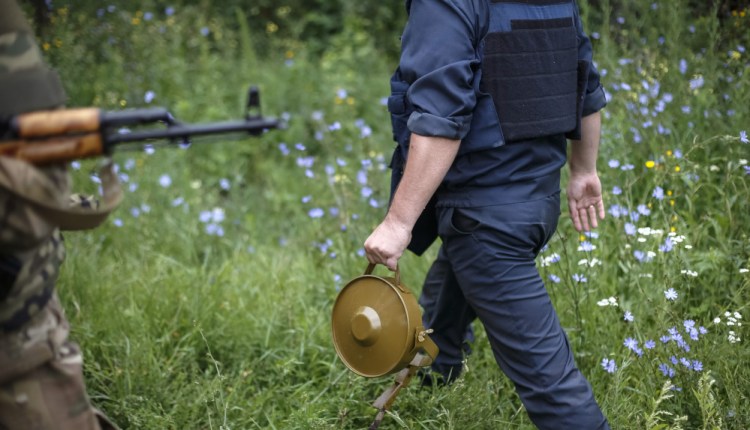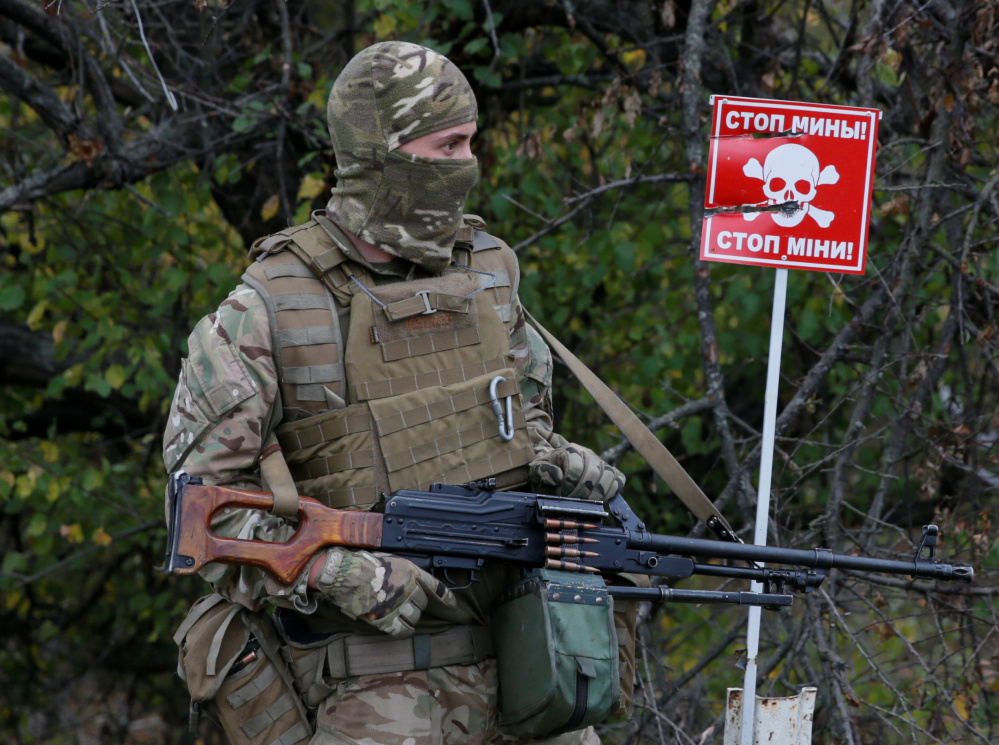MYRNA DOLYNA, Ukraine —In an overgrown minefield, Yulia Boiko kneels down and starts gardening. Years of war have caused weeds to grow high in the abandoned croplands of eastern Ukraine. Clad in flak jacket and face mask, she uses shears to snip back sun-scorched scrub, removing vegetation one careful inch at a time to avoid hidden tripwires.
A small patch of earth is eventually exposed. Boiko stands up, then scans the ground with her metal detector to ensure it is clear. She repeats the painstaking process – one pace farther into a 600-acre field where wheat and sunflowers once grew.
The United Nations reports that this Donbas region is becoming one of the most mined areas in the world. Anti-vehicle mines in particular kill more people here than anywhere else in the world, researchers say – surpassing the numbers of victims in Syria, Yemen or battlefields across Africa.
“Nobody knows how big the problem is,” said Henry Leach, the head of the Danish Demining Group’s program in Ukraine. “We just know it’s big.”
Land mines, booby traps and unexploded ordnance are sown across tens of thousands of acres – much of it off-limits because the fighting is still going on and because of obstructions raised by officials.
RIDDLED WITH EXPLOSIVES
The Halo Trust, a humanitarian mine-clearance organization, estimates that land mines have caused 1,796 casualties in eastern Ukraine – among them 238 civilians killed and another 491 injured – since the start of the war in 2014. The rate of casualties from mines and unexploded ordnance has increased over the years, a trend likely to continue as displaced families return to areas where fighting has subsided, now riddled with explosive remnants.
In addition to the bloodshed, entire communities suffer. Both sides have laid land mines, denying people use of land for crops and livestock, and endangering those who gather firewood. Local economies stagnate, damaged infrastructure goes unrepaired, cease-fire monitors are hampered.
That’s why Boiko – a 29-year-old mother of one from Mariupol – and her mine-clearance colleagues are deployed near the village of Myrna Dolyna (“Peaceful Valley”). Following clashes in 2014 and 2015, the presence of these deadly devices has paralyzed the small agricultural community, close to the front line in government-held Luhansk region.
Deaths of three Ukrainian soldiers from a land-mine blast here last year put the area on the radar of the Danish Demining Group. Its manpower is drawn from the local population; supervisors say that risks are manageable and that training takes just a few weeks. In the Donbas twilight zone, this job is attractive. Pay is decent; the task, empowering. This site is expected to be cleared within a year.
“It’s a mix of gardening and archaeology,” Leach said. “We employ civilians, not specialists, so it’s less expensive and benefits local communities.”
Under a hot autumn sun, 10 men and women are scouring for a smorgasbord of Soviet-era weapons. Directional fragmentation mines look like “a dinner plate packed with explosives,” Leach said. “They’re particularly nasty.”
Powerful TM-62 antitank mines threaten farmers working the land. OZM-72 “bounding fragmentation” mines jump into the air when tripped, exploding at waist height to spray hundreds of steel shards into their victims.
“Black widow” mines contain up to a half-pound of TNT, while the toylike shape of “green parrots” caused a large number of child casualties during the Soviet-Afghan war. Elsewhere, the Ukrainian military has accused Russian-backed forces of laying mines attached to fishing lines, with hooks that snag soldiers’ clothes, setting off the explosives.
FINDING THE ‘MINE LINES’
In the field near Myrna Dolyna, deminers have cleared several lanes into the minefield, each one spaced at a safe distance in case of unexpected blasts. The manager is Colin Watson, a Scotsman with experience in Afghanistan, Mozambique, Somalia and elsewhere.
Sticks tipped with red paint mark the division between secured areas and those yet to be cleared. One goal is to find “mine lines” – explosives fanning into an invisible, defensive barrier.
So prevalent are Donbas land mines that some farmers nickname them “potatoes.” Overlooking rebel-held Horlivka, Vadym Kaplya owns “Dynasty” farm (which his mother named after the soap opera). The front line cleaves his land in half. Plots of wheat are scorched by shelling, while wrecked tractors lie mangled by indiscriminate antitank mines.
“We tell ourselves, ‘There’s a potato, don’t go there,’ ” Kaplya told the Ukrainian online television channel Hromadske.
Most minefields are around the front line, where military commanders typically restrict demining. “There’s almost a blanket ban on survey and clearance in those areas,” said Patrick Thompson, operations manager for the Halo Trust in Ukraine. “If we want access, we have to apply to the [Defense Ministry]. … Most commonly, we never get a response.”
And banned from separatist-held territory, international mine-clearance organizations have no idea of the scale of the problem there.
Eastern Ukraine is “rapidly becoming one of the most mined areas in the world,” the U.N. deputy chief of humanitarian affairs, Ursula Mueller, said recently, “which, if not addressed, will stall reconstruction and development for many years to come.”
Send questions/comments to the editors.




Success. Please wait for the page to reload. If the page does not reload within 5 seconds, please refresh the page.
Enter your email and password to access comments.
Hi, to comment on stories you must . This profile is in addition to your subscription and website login.
Already have a commenting profile? .
Invalid username/password.
Please check your email to confirm and complete your registration.
Only subscribers are eligible to post comments. Please subscribe or login first for digital access. Here’s why.
Use the form below to reset your password. When you've submitted your account email, we will send an email with a reset code.